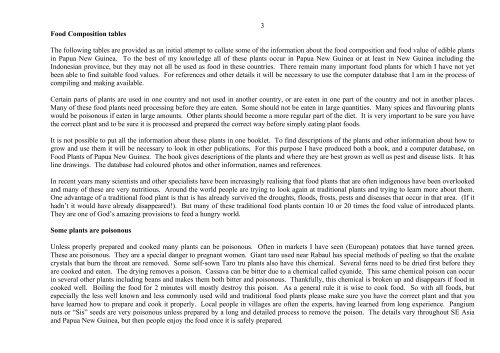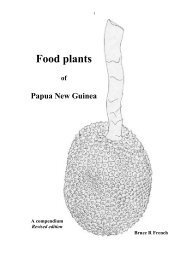Food Composition PNG plants - Food Plants International
Food Composition PNG plants - Food Plants International
Food Composition PNG plants - Food Plants International
Create successful ePaper yourself
Turn your PDF publications into a flip-book with our unique Google optimized e-Paper software.
<strong>Food</strong> <strong>Composition</strong> tables<br />
3<br />
The following tables are provided as an initial attempt to collate some of the information about the food composition and food value of edible <strong>plants</strong><br />
in Papua New Guinea. To the best of my knowledge all of these <strong>plants</strong> occur in Papua New Guinea or at least in New Guinea including the<br />
Indonesian province, but they may not all be used as food in these countries. There remain many important food <strong>plants</strong> for which I have not yet<br />
been able to find suitable food values. For references and other details it will be necessary to use the computer database that I am in the process of<br />
compiling and making available.<br />
Certain parts of <strong>plants</strong> are used in one country and not used in another country, or are eaten in one part of the country and not in another places.<br />
Many of these food <strong>plants</strong> need processing before they are eaten. Some should not be eaten in large quantities. Many spices and flavouring <strong>plants</strong><br />
would be poisonous if eaten in large amounts. Other <strong>plants</strong> should become a more regular part of the diet. It is very important to be sure you have<br />
the correct plant and to be sure it is processed and prepared the correct way before simply eating plant foods.<br />
It is not possible to put all the information about these <strong>plants</strong> in one booklet. To find descriptions of the <strong>plants</strong> and other information about how to<br />
grow and use them it will be necessary to look in other publications. For this purpose I have produced both a book, and a computer database, on<br />
<strong>Food</strong> <strong>Plants</strong> of Papua New Guinea. The book gives descriptions of the <strong>plants</strong> and where they are best grown as well as pest and disease lists. It has<br />
line drawings. The database had coloured photos and other information, names and references.<br />
In recent years many scientists and other specialists have been increasingly realising that food <strong>plants</strong> that are often indigenous have been overlooked<br />
and many of these are very nutritious. Around the world people are trying to look again at traditional <strong>plants</strong> and trying to learn more about them.<br />
One advantage of a traditional food plant is that is has already survived the droughts, floods, frosts, pests and diseases that occur in that area. (If it<br />
hadn’t it would have already disappeared!). But many of these traditional food <strong>plants</strong> contain 10 or 20 times the food value of introduced <strong>plants</strong>.<br />
They are one of God’s amazing provisions to feed a hungry world.<br />
Some <strong>plants</strong> are poisonous<br />
Unless properly prepared and cooked many <strong>plants</strong> can be poisonous. Often in markets I have seen (European) potatoes that have turned green.<br />
These are poisonous. They are a special danger to pregnant women. Giant taro used near Rabaul has special methods of peeling so that the oxalate<br />
crystals that burn the throat are removed. Some self-sown Taro tru <strong>plants</strong> also have this chemical. Several ferns need to be dried first before they<br />
are cooked and eaten. The drying removes a poison. Cassava can be bitter due to a chemical called cyanide. This same chemical poison can occur<br />
in several other <strong>plants</strong> including beans and makes them both bitter and poisonous. Thankfully, this chemical is broken up and disappears if food in<br />
cooked well. Boiling the food for 2 minutes will mostly destroy this poison. As a general rule it is wise to cook food. So with all foods, but<br />
especially the less well known and less commonly used wild and traditional food <strong>plants</strong> please make sure you have the correct plant and that you<br />
have learned how to prepare and cook it properly. Local people in villages are often the experts, having learned from long experience. Pangium<br />
nuts or “Sis” seeds are very poisonous unless prepared by a long and detailed process to remove the poison. The details vary throughout SE Asia<br />
and Papua New Guinea, but then people enjoy the food once it is safely prepared.



